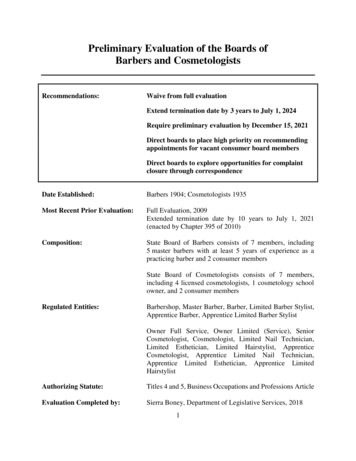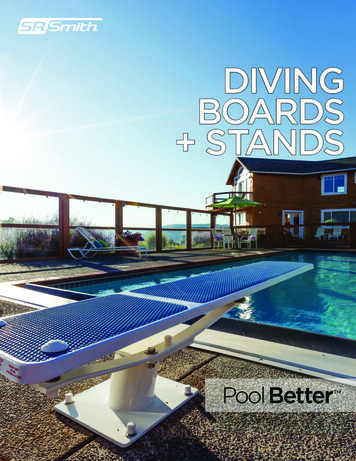
Transcription
Preliminary Evaluation of the Boards ofBarbers and CosmetologistsRecommendations:Waive from full evaluationExtend termination date by 3 years to July 1, 2024Require preliminary evaluation by December 15, 2021Direct boards to place high priority on recommendingappointments for vacant consumer board membersDirect boards to explore opportunities for complaintclosure through correspondenceDate Established:Barbers 1904; Cosmetologists 1935Most Recent Prior Evaluation:Full Evaluation, 2009Extended termination date by 10 years to July 1, 2021(enacted by Chapter 395 of 2010)Composition:State Board of Barbers consists of 7 members, including5 master barbers with at least 5 years of experience as apracticing barber and 2 consumer membersState Board of Cosmetologists consists of 7 members,including 4 licensed cosmetologists, 1 cosmetology schoolowner, and 2 consumer membersRegulated Entities:Barbershop, Master Barber, Barber, Limited Barber Stylist,Apprentice Barber, Apprentice Limited Barber StylistOwner Full Service, Owner Limited (Service), SeniorCosmetologist, Cosmetologist, Limited Nail Technician,Limited Esthetician, Limited Hairstylist, ApprenticeCosmetologist, Apprentice Limited Nail Technician,Apprentice Limited Esthetician, Apprentice LimitedHairstylistAuthorizing Statute:Titles 4 and 5, Business Occupations and Professions ArticleEvaluation Completed by:Sierra Boney, Department of Legislative Services, 20181
Overview of Regulatory ActivityThe State Board of Barbers and the State Board of Cosmetologists are 2 of 21 regulatoryboards and commissions within the Division of Occupational and Professional Licensing in theDepartment of Labor, Licensing, and Regulation (DLLR). The State Board of Barbers wasestablished by Chapter 226 of 1904, and the State Board of Cosmetologists was established byChapter 282 of 1935. Both boards were originally established to protect the public from physicalharm caused by tools and chemicals by licensing individuals practicing barbering and cosmetologyand to ensure that shops and schools operate under sanitary conditions. Chapters 479 and 481 of1991 transferred responsibility for overseeing and regulating barbering and cosmetology schools,both public and private, to the Maryland State Department of Education and the Maryland HigherEducation Commission, respectively. However, the boards continue to be responsible for ensuringthat schools abide by standards for sanitation, and they both establish curriculum standards to beused by the education agencies in approving applications by entities wishing to provide instructionin the areas of barbering and cosmetology.As defined by statute, the practice of barbering means, for compensation: cutting, razor cutting, styling, relaxing, body waving, shampooing, or coloring the hair; shaving or trimming the beard; massaging the face; designing, fitting, or cutting a hairpiece; or performing other similar procedures on the hair, beard, face, or hairpiece of an individual.Statute defines the practice of cosmetology as, for compensation: providing hair services, arching or dyeing of eyebrows; dyeing eyelashes; providing esthetic services; or providing nail technician services.Each board regulates several license types, each with its own requirements, as shown inAppendix 1. Both boards also register apprentices; requirements for apprentice registrations arenot shown in the appendix, but generally the registrant must be at least 16 years old and have a2
licensed sponsor as a condition of registration. In addition, salons and barbershops must have validpermits from their respective boards, and licenses for practitioners are valid only to the extent thatlicensees are employed by a salon or barbershop with a valid permit. In general, barbering andcosmetology services must be provided only in barbershops or salons with valid permits, but thereare exceptions for specified mobile salons and barbershops, schools, nursing homes, and prisons.Both boards are responsible for overall regulation, governance, and discipline of licenseeswith regard to practicing their occupation, including setting and enforcing sanitation standards andensuring appropriate supervision of apprentices. In recent years, statutes have expanded thenumber of limited license opportunities, as discussed below.In general, licenses, permits, and registrations are valid for two years, except some limitedapprentice registrations that are valid only for one year. Licensing, registration, and permit fees,shown in Appendix 2, are among the lowest of the industries regulated by DLLR and have notchanged since 1997. Fee-setting authority is discussed further in the next section.Legislative Activity Since Last EvaluationAppendix 3 summarizes the statutory changes affecting the two boards that have beenenacted since the last full evaluation was completed in 2009. Major changes include (1) thecreation of limited licenses to perform a variety of hair services; (2) the addition of a continuingeducation (CE) requirement for individuals renewing their license with the State Board ofCosmetologists; and (3) the establishment of a special joint, nonlapsing fund that enables thetwo boards to retain revenues generated by licensing and other fees instead of paying them to theGeneral Fund. There has also been legislation that allow salons in Frederick, Montgomery, andSt. Mary’s counties to provide alcohol to customers.Chapter 492 of 2016 created a new permit that enables a beauty salon owner or barbershopowner to obtain a secondary permit for one or more or mobile beauty salons or barbershops,respectively. To qualify for a mobile salon/barbershop permit, an applicant must (1) hold a permitto operate a traditional salon or barbershop and (2) own or lease the motor vehicle or trailer inwhich the mobile salon/barbershop is located.Licensing ActivityBarbering and cosmetology are similar in nature, but both industries see themselves asunique and distinct. While barbering has remained relatively consistent, cosmetology hasexpanded as a profession to include a wide variety of activities with the introduction of nailtechnicians and estheticians as a part of the cosmetology industry. Appendices 4 and 5 show thenumbers of licenses and permits issued by both boards, by type. Because barber and cosmetologylicenses are renewed every two years, analysis of licensing trends must be done on a biennial basis;for instance, issuances in even-numbered years must be compared with those in othereven-numbered years.3
Since fiscal 2014, the number of new cosmetologist licenses has declined slightly (from1,579 in fiscal 2014 to 1,279 in fiscal 2018), which may be due to more people choosing limitedlicenses; for instance, the number of new nail technician licenses doubled, from 229 to 454, overthe same time period. While the number of barbers is much lower than the number ofcosmetologists, in part because of more limited services, the number of new and renewed barberlicenses has generally grown modestly since fiscal 2014.Previous evaluations have revealed the existence of unlicensed barbering and cosmetologyservices, which generally fall into two categories. Some individuals simply practice barbering orcosmetology without a valid license, while others may have an individual license, but do notprovide services in a shop with a valid permit, as required by law. Often, unlicensed services areprovided out of private homes. A reliable estimate of unlicensed providers is not possible becausethe board generally becomes aware of them only when they receive a related complaint and alsobecause the board does not have the authority to enter or inspect private homes, but unlicensedservices are believed to be fairly prevalent.Complaints and EnforcementsAs shown in Appendices 6 and 7, the majority of complaints are either related to sanitationor an unlicensed employee or shop. If complaints are related to license status or sanitation, theinspection team conducts an inspection of the location. These inspections are conducted withoutnotice and are in addition to the annual surprise inspections conducted in salons and barbershops.The previous sunset evaluation noted an increase in complaints for the State Board ofCosmetologists that resulted in a backlog of unresolved cases, but since then, the number ofcomplaints has remained relatively consistent. Complaints have also begun to be receivedelectronically, and while this has increased the amount of complaint correspondence received byshared board staff, complaints are now able to be more swiftly and efficiently processed.The boards try to maintain a standard of resolving complaints within a 45-day time frame,but the appendices show that they have struggled to consistently meet this expectation. Forinstance, more than half of the complaints received by the State Board of Cosmetologists in 2015remain unresolved. The boards cite several reasons for this. First, there have been technical issueswith the complaint system that have resulted in complaints being logged as open in their databasewhen they have actually been closed. As of June 2018, board staff have been using a new complainttracking application to more efficiently document complaints. In transferring records from the oldsystem to the new system, staff have identified a number of erroneous entries in the old system butdo not yet know the full extent of the problem. It is quite possible that many of the cases shown tobe open from previous years may in fact be closed, but a reliable determination cannot be made atthis time.Second, both boards require that resolved complaints be brought to the board for finalapproval. The State Board of Barbers meets only quarterly, so even if the necessary actions havebeen completed and penalties have been paid, the complaint is still technically open until the board4
officially closes it at the board meeting. The State Board of Cosmetologists meets monthly andalso maintains a complaint committee to exclusively address complaints, so the issue of meetingfrequency is less of a factor.Finally, some complaints remain open because licensees who are the subject of thecomplaints pay the required penalties but do not appear before the board, which both boards requireas a condition for closing complaints. As a result, their cases remain open even though penaltieshave been assessed and paid.FinancesFor many years, the two boards have shared staff, which is a major reason why their sunsetevaluations have been done in conjunction with each other. Prior to fiscal 2019, licensing fees forboth boards were paid to the General Fund, and expenditures were funded by general fundrevenues. The 2009 sunset evaluation recommended that the boards be special funded so that theycould retain more of the revenues they generate through fees and, thus, have the resourcesnecessary to adequately regulate their respective professions. Chapter 256 of 2017 established theState Barbers and Cosmetologists Boards’ Fund as a special, nonlapsing fund whose revenueconsists of fees collected from the State Board of Barbers and the State Board of Cosmetologists.Beginning in fiscal 2019, the fund is used to cover the actual documented direct and indirect costsof fulfilling the statutory and regulatory duties of the two boards. At the end of each fiscal year,any unspent and unencumbered portion of special funds in excess of 100,000 reverts to theGeneral Fund. Chapter 256 also capped any fee increases approved by each board at no more than12.5% of the prior fee. While license revenue from the boards accrues to the special fund, anyinvestment earnings and penalty revenue will continue to accrue to the general fund.Both boards have consistently collected revenue that has far exceeded their general fundappropriations annually, as shown in Exhibit 1. Creating the dedicated special fund gives themthe resources that they need to hire the additional staff necessary to properly regulate thetwo professions. With the transition to special funding, the boards have added 2 staff to supportboth administrative and investigative duties for the boards. There will also be a slight increase inindirect costs (to a combined 55,900) to support the boards beginning in fiscal 2019. The licensingrevenue generated annually is sufficient to support the increase in staff as well as the slight increasein indirect costs for the boards. Exhibit 2 outlines the projected revenue and expendituresbeginning in fiscal 2019, the year that the special funding takes effect. The exhibit also shows theincreased operating costs related to the additional staff, and subsequent reversions to theGeneral Fund.5
Exhibit 1Combined Board Revenues and ExpendituresFiscal 2014-20182014Revenues2015201620172018 1,136,321 1,152,249 1,174,751 1,167,482 1,197,042ExpendituresIndirect CostsPersonnelTechnical and Special FeesPostage/TelephoneTravelMotor VehicleContractualEquipment, Supplies, andMaterialsFixed ChargesTotal Expenditures 50,000229,85310,83934,06014,384924282,455 50,000322,1598,9153,14116,056924301,178 50,000333,68137,60622,11220,0371,540328,004 50,000322,22466,13039,30214,4461,028238,760 50,000274,76199,49140,61211,458996215,1501,908310 624,7332,406350 705,1292,1560 795,136255460 732,605810310 693,588Excess (Gap) 511,588 447,120 379,615 434,877 503,454Note: Fiscal 2018 amounts are estimates.Source: State Board of Barbers; State Board of Cosmetologists6
Exhibit 2Special Fund ProjectionsFiscal 2019-2023201920202021 01,152,074 1,152,074 100,0001,200,494 1,300,494 100,0001,152,074 1,252,074Existing CostsNew Staff CostsIndirect CostsTotal Costs 690,536152,61455,894 899,044 693,988149,88955,894 899,771 697,458156,81855,894 910,170 700,945164,14355,894 920,982 704,450171,89155,894 932,235Balance Before ReversionReversionEnd of Year Balance 253,030153,030 100,000 400,723300,723 100,000 341,903241,903 100,000 379,511279,511 100,000 319,839219,839 100,000Beginning BalanceRevenueTotal Available Funds20222023 100,000 100,0001,200,494 1,152,074 1,300,494 1,252,074Source: Department of Legislative ServicesExhibits 1 and 2 both show that the boards will be operating with a substantial surplus,much of which is scheduled to revert to the General Fund at the end of each year. However, theboards may need additional staff, even beyond the 2 positions recently added, to address gaps inthe services they provide. For instance, the State Board of Cosmetologists has not yet implementedthe CE requirement enacted by Chapter 784 of 2017 because it has lacked sufficient staff to do soand monitor compliance.As previously mentioned, licensing fees have not been changed since 1997, and thelicensing fees for both barbers and cosmetologists are historically low. Known additional staffingneeds can be covered by anticipated fund surpluses. Should other costs be incurred, it may benecessary in the future to increase licensing fees.Other Statutory, Industry, or Programmatic IssuesApprenticeshipsRegulations specifically require a master barber or senior cosmetologist who is mentoringan apprentice to (1) ensure that the apprentice receives the required theory and practical training;(2) ensure that the apprentice receives at least 20 (cosmetology) hours of training each week;(3) file a monthly report with the board stating the progress of the apprentice; and (4) advise the7
board, in writing, when an apprenticeship is discontinued. After having completed the requiredhours of apprenticeship, the apprentice may take the exam for full licensure.Progress reports filed in a timely manner by the master barber or senior cosmetologist arerequired for the apprentice to take the examination for full licensure. If a monthly report is notreceived by the appropriate board within 90 days of the training period being reported, the boardmay decide to not give credit for the training. In previous years, there has been a consistent lackof accountability in tracking the submission of progress reports, and the boards did not notifyapprentices that their reporting requirement had not been met. As a result, there were numerousrequests for both renewal and restarts of apprenticeship licenses due to failure to meet the trainingcommitments in the initial license term. In response to this issue, board staff have implemented anew electronic filing system for reporting of apprenticeship hours. The apprenticeship sponsor candocument the number of apprentice hours logged and the nature of work completed on the DLLRwebsite. This documentation is immediately submitted to the appropriate board and to theapprentice so that all stakeholders are informed and accountable to the apprenticeship process. Asa result, there has been a decrease in the number of apprenticeship renewals requested due to lackof documentation of apprenticeship hours.As apprenticeships in Maryland have gained both support and federal funding, the boardshave begun work to transition the current apprenticeship program to a nationally registeredapprenticeship program based on the federal standards. This would result in a more structuredtraining curriculum for apprentices and streamline the process for receiving credit forapprenticeship hours.ReciprocityBoth boards are authorized to waive an individual licensed to practice in any other statefrom the licensing exam requirement if the individual (1) otherwise meets the statutoryqualifications; (2) became licensed in another state after passing an exam that is at least equivalentto the Maryland exam; and (3) for barbers, practiced barbering in another state during the two yearsprior to applying for a Maryland license. In these cases, a candidate for an exam waiver mustprovide a sealed endorsement from the state in which he or she is currently licensed confirminglicensure in that state and pay an endorsement fee to the appropriate board. Board staff confirmsall endorsements received from other states, typically by conducting searches on other boards’websites.There are preliminary discussions surrounding the reciprocity program for barbers becausethe two-year requirement for barbers has caused many otherwise eligible barbers not to receivetheir reciprocal license. It is suspected that the inability to receive a reciprocal license is a majorreason for the existence of unlicensed barbers in the State. The State Board of Barbers is currentlyexploring strategies to streamline reciprocity to make it easier for otherwise qualified individuals.8
Consumer Member VacanciesEvery evaluation report submitted in the last 20 years has noted frequent and persistentvacancies among the consumer members on the two boards. The difficulty in filling consumerpositions on the boards continues today. As the variety of licensure options continues to expand,the interests of different license holders and their consumers expands as well. Consumer presenceon the boards offers an opportunity for representation of interests outside of salon and shop owners.In addition, consumer membership offers an opportunity to engage constituents that willhave an interest in how regulations and governance decisions affect the service they receive froma cosmetologist or barber. For instance, the examinations are only offered in English, Spanish, andVietnamese. The Institute for Justice brought to the attention of the Board of Cosmetologists thehigher number of exam takers that speak Mandarin Chinese and how this may contribute to thepass rate for the exam, particularly on the theory portion of the examination. The Department ofLegislative Services (DLS) recommends that the boards work with the Secretary’s Office toplace a high priority on recommending consumer members of the boards to the Governor.Conclusion and RecommendationsAlthough the boards appear to be operating within their statutory authority and haveaddressed some of the deficiencies identified in the previous full evaluation, DLS identifiedthree potential operational shortcomings. First, the boards (particularly cosmetologists) cannotreliably tell how many complaints have been closed following an investigation and possibledisciplinary action. Reported figures show substantial backlogs of unresolved complaints.However, the boards advise that those figures are not reliable due to data quality issues with theprior complaint tracking system and that they are working to resolve those issues, but that will taketime. Second, the State Board of Cosmetologists has not yet implemented the CE requirementenacted by Chapter 784 due to staffing shortages. A third area of concern, the persistent vacanciesamong consumer members on the boards, is largely beyond the boards’ authority because theGovernor, in consultation with the Secretary of Labor, Licensing, and Regulation, is responsiblefor filling vacancies on the boards.The issues described above are normally sufficient to prompt a recommendation from DLSthat the Legislative Policy Committee either authorize a full evaluation to be conducted thefollowing year or require a follow-up report. However, DLS notes that the boards are in thefirst year of operation with a new special fund that was established to provide sufficient resourcesto address staffing deficiencies. The resources made available to the boards by virtue of thetransition to a special fund may enable them to address the areas of concern within a reasonabletime frame, and indications are that the boards are at least aware of the need to address them.Therefore, DLS believes that it is premature to conduct a full evaluation at this time butrecommends that progress in these areas be assessed in three years.9
Accordingly, DLS recommends that the boards be waived from a full evaluation butthat legislation be enacted to reauthorize the boards for three years, with anotherpreliminary evaluation required during the 2021 interim.10
Appendix 1License and Permit RequirementsLicense TypeRequirementsCosmetologistMust (1) be at least 17 years of age and have completedgrade 9 or equivalent; (2) complete either 1,500 hours oftraining in a cosmetology school or 24 months as aregistered apprentice in a beauty salon with a permit; and(3) pass an examination given by the board.HairstylistMust (1) be at least 17 years of age and have completedgrade 9 or equivalent and (2) complete 1,200 hours oftraining in a cosmetology school or 15 months as aregistered apprentice in a beauty salon with a permit.EstheticianMust (1) be at least 17 years of age and have completedgrade 9 or equivalent and (2) complete 600 hours oftraining in a cosmetology school or 6 months as aregistered apprentice in a beauty salon with a permit.Nail TechnicianMust (1) be at least 17 years of age and have completedgrade 9 or equivalent and (2) complete at least 250 hoursof training in a cosmetology school or 3 months as aregistered apprentice in a beauty salon with a permit.Senior CosmetologistMust have 2 years of experience as a licensedcosmetologist and passing grades on the seniorcosmetologist examination.BarberMust complete 1,200 hours of barber student training in abarber school or 2,250 hours as a registered apprentice ina barbershop with a permit and pass an examination givenby the board.Barber-stylist LimitedMust complete 900 hours of barber student training in abarber school or 1,650 hours as an apprenticebarber-stylist limited in a barbershop with a permit andpass an examination given by the board.Master BarberMust have 15 months of experience as a licensed barberand a passing grade on the master barber examination.Owner Salon/Barbershop PermitMust own or lease the facility and pass inspection.Limited owner licenses available for manicuring oresthetic services.Source: Laws of Maryland11
Appendix 2Licensing and Renewal FeesOriginalRenewalLate FeeCosmetologistEstheticianNail TechnicianSenior CosmetologistOwner Salon*Owner Limited Practice*Cosmetology ApprenticeNail Technician ApprenticeEsthetician Apprentice 25252525200200101010 252525255050101010 252525255050n/an/an/aBarberMaster BarberShop Owner*ApprenticeLicense CertificationBarber (duplicate)Shop Owner n/an/an/an/a* Owner fee includes one-time inspection fee of 150 in the original fee.Source: Code of Maryland Regulations12
Appendix 3Legislative Changes Related to Cosmetologists and BarbersYearChapterChange395 Extends the termination dates for the State Board of Barbers and State Board of Cosmetologists by 10 years toJuly 1, 2021, and requires evaluation of the boards prior to their termination.2013412 Establishes a limited license under the State Board of Cosmetologists that authorizes the licensee to perform hairservices exclusively under specific conditions.2014387 Authorizes the Montgomery County Board of License Commissioners to issue a special beauty salon beer andwine license to a holder of a beauty salon permit.2015262 Establishes a limited license issued by the State Board of Barbers for barber-stylist services under specificconditions.2016127 Authorizes the Frederick County Board of License Commissioners to issue a special beauty salon beer and winelicense to a holder of a beauty salon permit.434 and 435 Establish a limited license by the State Board of Cosmetologists to provide “hair services-blow drying” andintegrate the license into the existing regulatory framework.132010492 Enables a beauty salon owner or barbershop owner to obtain a secondary permit for one or more or mobile beautysalons or barbershops, respectively, based on certain qualification criteria.2017198 Repeals criminal penalties for violating barbering laws.256 Establishes the State Barbers and Cosmetologists Boards’ Fund as a special, nonlapsing fund in the Department ofLabor, Licensing, and Regulation effective July 1, 2018, making both boards special funded beginning infiscal 2019.289 Authorizes the St. Mary’s County Board of License Commissioners to issue a special beauty salon beer and winelicense to a holder of a beauty salon permit.784 Requires an individual renewing a license from the State Board of Cosmetologists to complete at least six credithours of continuing education (CE) approved by the board. The board must adopt regulations that set standards forthe CE courses that, at a minimum, require two hours of training in health, safety, and welfare subjects andfour hours of training in general elective courses.Source: Laws of Maryland
Appendix 4Cosmetology Licenses and Permits by TypeFiscal 2014-2018Shop PermitsOwner Limited – NewOwner Limited – RenewalOwner Full Service – NewOwner Full Service – RenewalCosmetology LicensesSenior Cosmetologist – NewSenior Cosmetologist – RenewalCosmetologist – NewCosmetologist – RenewalLimited Nail Technician – NewLimited Nail Technician – RenewalLimited Esthetician – NewLimited Esthetician – RenewalApprentice Cosmetologist – NewApprentice Cosmetologist – RenewalApprentice Limited Nail Technician – NewApprentice Limited Nail Technician – RenewalApprentice Limited Esthetician – NewApprentice Limited Esthetician – RenewalLimited Hairstylist – NewLimited Hairstylist – RenewalApprentice Limited Hairstylist – NewApprentice Limited Hairstylist – RenewalSource: State Board of 95873,310 3,3231,579 1,33612,281 12,4272292303,575 3,4952341911,497 4681,588812524971,555711053,149 3,2271,650 1,39812,663 12,8373113213,553 3,4572912821,506 24543,4973091,67994621661266515-832694731,708
Appendix 5Barber Licenses by TypeFiscal 2014-2018Shop PermitsBarbershop – NewBarbershop – RenewalBarber LicensesBarber – NewBarber – RenewalMaster Barber – NewMaster Barber – RenewalApprentice Barber – NewApprentice Barber – RenewalLimited Barber Stylist – NewApprentice Limited Barber Stylist – 4529461241916Source: State Board of Barbers15
Appendix 6Cosmetology Complaints by Type and OutcomeFiscal 2014-201820142015201620172018Unlicensed SalonUnlicensed PersonnelSanitationProhibited ServiceService Issue/Monetary 2139528181382536731021165Dismissed – UnsubstantiatedDismissed – OrderConsent Order (Completed)Consent Order (Pending)Unresolved – Investigation 621304171385317182057165* Reflects investigation still designated as ongoing as of November 2018.Source: State Board of Cosmetologists16
Appendix 7Barber Complaints by Type and OutcomeFiscal 2014-201820142015201620172018Unlicensed ShopUnlicensed PersonnelSanitationProhibited ServiceService Issues/Monetary 335Dismissed – UnsubstantiatedDismissed – OtherConsent Order (Completed)Consent Order (Pending)Unresolved – Investigation 335* Reflects investigation still designated as ongoing as of November 2018.Source: State Board of Barbers17
Appendix 8Written Comments of the State Board of Barbers andState Board of CosmetologistsThe boards reviewed a draft of this preliminary evaluation and provided these written comments.18
--DSTATEOFMARL. YLANDLROFFICE OF THE SECRETARY500 North Calvert Street4 th Floo rD EPARTMENT OF LABOR, LICENSING AND REGULATION B a lt im o r e, M D 2 12 02-December 4 , 2018Michael RubensteinPrincipal Policy AnalystOffice of Policy AnalysisDepartment of Legislative Services90 State CircleAnnapolis, MD 21401-1991Dear Mr. Rubenstein:The Department of Labor, Licensing and Regulation and the boards of cosmetologists andbarbers have received the draft of the preliminary evaluation conducted by the Department ofLegislative Services (DLS) pursuant to the Maryland Program Evaluation Act. We appreciatethe time, professionalism and attention that DLS spent reviewing
State Board of Cosmetologists consists of 7 members, including 4 licensed cosmetologists, cosmetology school 1 owner, and 2 consumer members . . both public and private, to the Maryland State Department of Education and the Maryland Higher Education Commission, respectively. However, the boards continue to be responsible for ensuring










